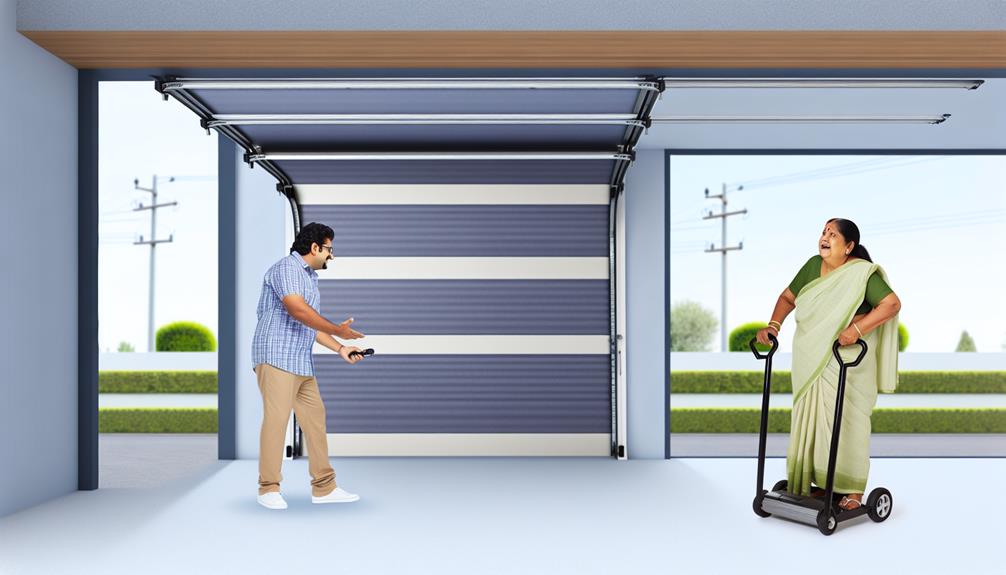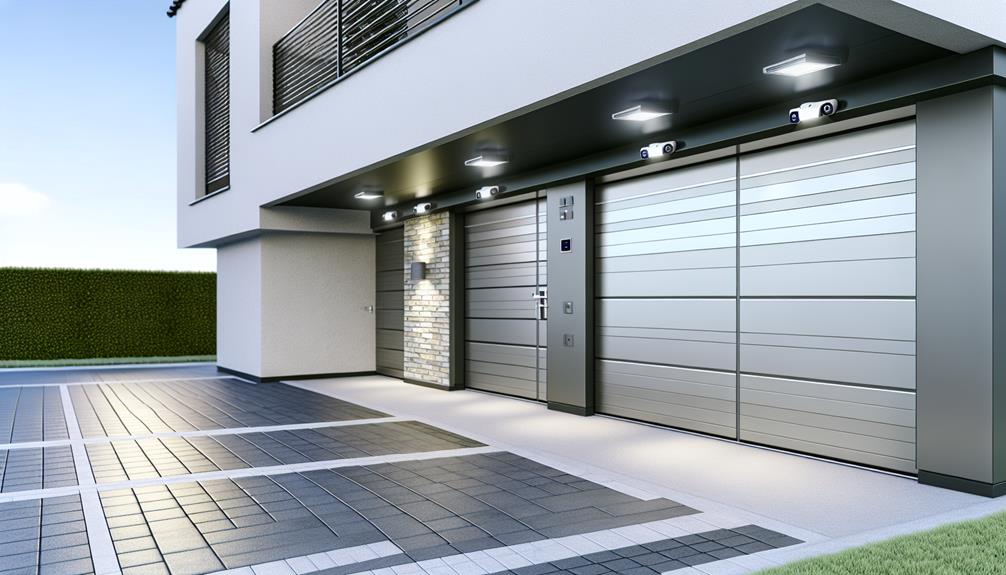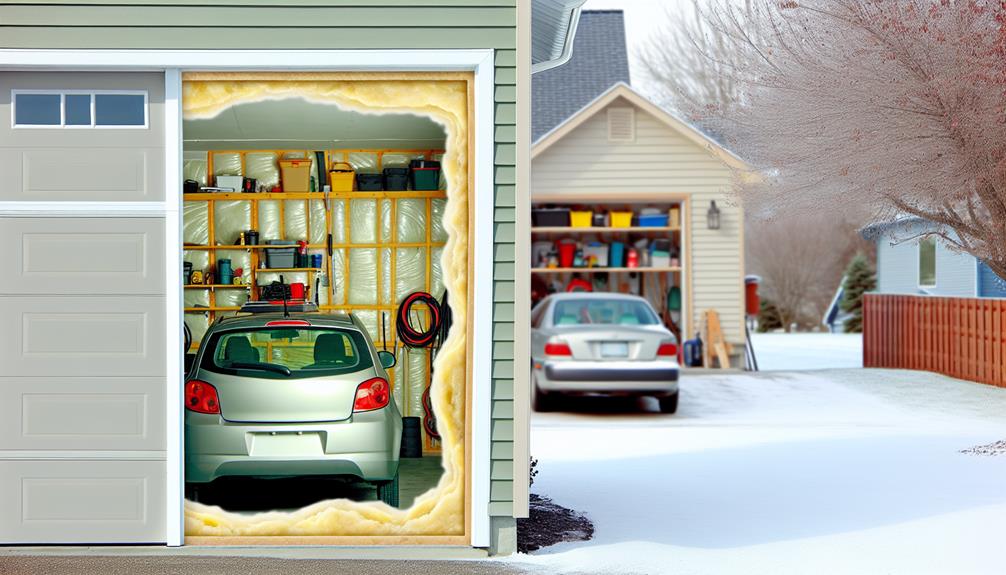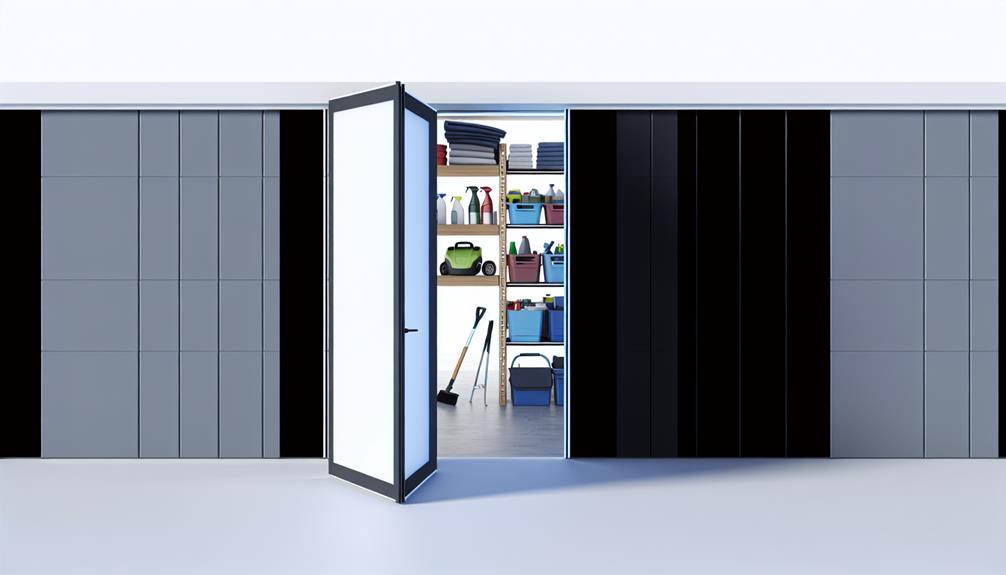
Sectional garage doors offer ease of operation with counterbalance springs and automated systems, enhancing your convenience. They maximize space efficiency by operating vertically, perfect for tight garages. You’ll benefit from enhanced security with robust locking mechanisms and multi-layered materials, which also contribute to superior insulation and energy efficiency. Varied design options allow personalization to match your home’s aesthetic. However, they require regular maintenance, and potential mechanical failures can be a downside. Additionally, noise during operation and high initial costs should be considered. Explore more about the maintenance demands and long-term benefits to decide if it’s the best fit for you.

When evaluating the ease of operation of sectional garage doors, one immediately notices their user-friendly design.
You’ll find that these doors are engineered with counterbalance springs, which take on the door’s weight and make manual operation almost effortless. If you opt for an automated system, the integration of electric motors and remote controls further simplifies the process. You can open and close your garage door with just the push of a button.
The sectional design also guarantees smooth operation. Each panel is connected with robust hinges, allowing the door to glide seamlessly along its tracks.
Bearings and rollers, typically made from high-quality materials like nylon or steel, reduce friction and noise, making the door’s movement quieter and more efficient.
You’ll appreciate the safety features as well. Modern sectional garage doors often come equipped with sensors that detect obstructions and reverse the door’s movement to prevent accidents.
Additionally, the tension of the springs is adjustable, providing you with the ability to fine-tune the door’s operation to suit your needs.
Not only are sectional garage doors user-friendly, but they also excel in space efficiency. When considering the layout of your garage, sectional doors offer a unique advantage. Unlike traditional up-and-over garage doors that require ample clearance in front of the garage, sectional doors operate vertically. They slide upwards and rest parallel to the ceiling, guaranteeing you maximize the usable space both inside and outside your garage.
This vertical operation is particularly beneficial if you need to park close to the door or if space constraints are an issue. You’ll also avoid the problem of swinging doors that can interfere with objects stored nearby or obstruct movement.
Additionally, sectional doors are comprised of hinged panels, allowing them to curve as they move along a track. This flexibility means they can fit into garages with low headroom or unusual shapes.
The counterbalance spring system used in sectional doors guarantees smooth, controlled movement, reducing wear and tear on the door mechanism. This system also minimizes the force required to operate the door, enhancing ease of use.

You’ll find that sectional garage doors offer enhanced security through robust locking mechanisms that resist tampering and forced entry.
These doors are constructed with advanced material strength, making them difficult to breach.
Ensuring your garage’s safety, these features deter potential intruders and protect your property effectively.
A considerable advantage of sectional garage doors lies in their robust locking mechanisms, which provide enhanced security for your home.
You’ll find that these doors are equipped with multi-point locking systems that engage at several points along the door frame. This greatly reduces the likelihood of forced entry, as an intruder would have to bypass multiple secure points simultaneously.
Additionally, sectional garage doors often incorporate advanced locking technologies such as anti-lift devices. These mechanisms prevent the door from being forcibly lifted, adding an extra layer of security.
You can also opt for electronic locking systems, which integrate seamlessly with smart home security solutions. These electronic locks can be controlled remotely via your smartphone, allowing you to monitor and manage the security of your garage from anywhere.
Moreover, the construction of sectional garage doors includes high-tensile materials that enhance the integrity of the locking mechanisms.
The combination of these strong materials and sophisticated locking technologies guarantees that your garage remains a secure entry point.
When you invest in a sectional garage door, you’re not just getting convenience and aesthetics—you’re also considerably boosting the security of your home with state-of-the-art locking systems.
In addition to robust locking mechanisms, the advanced material strength of sectional garage doors greatly contributes to their enhanced security. Modern sectional doors often incorporate high-tensile steel or reinforced aluminum, providing an added layer of protection against forced entry. These materials aren’t only resistant to impact but also to cutting and prying, making it greatly harder for intruders to breach.
You’ll find that many sectional garage doors are constructed with multiple layers, including insulation cores sandwiched between exterior and interior steel panels. This multi-layered design not only improves thermal efficiency but also augments structural integrity. The use of polyurethane or polystyrene foam within these layers further enhances rigidity, making the door exceptionally sturdy.
Moreover, the surface treatment of these doors often includes anti-corrosive coatings, ensuring long-term durability in various weather conditions. Galvanization and powder coating techniques add another degree of resilience, preventing rust and wear over time.
Additionally, the sectional design itself distributes mechanical stress more evenly, reducing the likelihood of material fatigue.
When it comes to sectional garage doors, the varied design options available are impressive and extensive. You can choose from a wide array of materials such as steel, aluminum, wood, and composite, each offering distinct aesthetic and functional benefits.
Steel doors provide durability and a sleek, modern look, while wooden options bring a classic, timeless appeal.
Color customization is another significant advantage. You can select from standard colors or opt for custom paint finishes to match your home’s exterior.
Additionally, there are numerous panel styles to take into account, including flush, raised, and recessed panels. Each style can dramatically alter the door’s appearance, allowing you to achieve a contemporary, traditional, or even rustic look.
Windows are another design feature worth pondering. You can incorporate different shapes, sizes, and glass types, such as frosted or tinted, to enhance both the door’s appearance and functionality.
Hardware options, like decorative handles and hinges, can further personalize your door, adding a unique touch.
Lastly, sectional garage doors can be tailored for specific architectural styles, from Victorian to mid-century modern. This versatility guarantees that your garage door not only serves its functional purpose but also complements your home’s overall design.

You’ll find that sectional garage doors offer superior insulation, greatly enhancing your home’s energy efficiency.
Their construction includes thick panels with insulating cores that effectively regulate indoor temperatures.
This means you can maintain a comfortable climate in your garage, reducing heating and cooling costs throughout the year.
A homeowner’s investment in sectional garage doors can greatly enhance energy efficiency through superior insulation.
These doors typically feature multiple layers, often including steel and polyurethane or polystyrene foam. The insulation core considerably reduces thermal exchange between your garage and the outdoors. By minimizing heat transfer, you can maintain a more stable temperature, which is essential for preventing energy loss.
The R-value, a measure of thermal resistance, is a vital factor to take into account. High R-value sectional doors offer excellent thermal resistance, meaning less energy is required to heat or cool your garage. This not only lowers your utility bills but also reduces your carbon footprint.
Additionally, the sectional design allows for a tighter seal compared to traditional one-piece doors. The interlocking panels and high-quality weather stripping minimize air leaks, ensuring that your garage remains well-insulated.
The advanced sealing technology further enhances the door’s energy efficiency by preventing drafts and moisture infiltration.
Investing in a sectional garage door with superior insulation can provide long-term savings and improve your home’s overall energy performance.
You’ll find that the initial cost is offset by the reduction in energy expenses, making it a smart, eco-friendly choice.
Keeping your garage at a consistent temperature couldn’t be easier with the insulation benefits of sectional garage doors. These doors typically feature multi-layer construction with materials such as steel, aluminum, and polyurethane foam. The foam acts as a thermal barrier, considerably reducing heat transfer between your garage and the outside environment. This enhanced insulation helps maintain a stable internal temperature, irrespective of external weather conditions.
Sectional garage doors often come with weather seals along the edges and between the panels. These seals further enhance temperature regulation by preventing drafts and minimizing air leakage. This is particularly beneficial if you use your garage as a workspace or storage area for temperature-sensitive items.
Moreover, the R-value of sectional garage doors is a critical factor in their insulation performance. The higher the R-value, the more effective the door is at insulating. For instance, a sectional door with an R-value of 16 can offer superior thermal resistance compared to a non-insulated door.
This not only aids in temperature regulation but also contributes to energy efficiency by reducing the load on your HVAC system. Ultimately, investing in a well-insulated sectional garage door could lead to substantial energy savings and enhanced comfort.
When it comes to cost considerations for sectional garage doors, several key factors come into play.
First, the initial purchase price varies greatly based on materials. Steel doors tend to be the most economical, while wood and composite options can cost considerably more. Insulation levels also impact cost; highly insulated doors generally come with a higher price tag but offer energy savings over time.
Next, consider the cost of installation. Professional installation is typically recommended for sectional doors due to their complexity, which adds to the overall expense. You might find yourself paying more for specialized labor, especially if your garage opening requires custom fitting or structural modifications.
Hardware and accessories further influence costs. Features such as advanced locking mechanisms, remote controls, and smart home integration can drive up the price. Additionally, keep in mind that sectional doors require regular maintenance to guarantee smooth operation, and these recurring costs should be factored into your budget.
Lastly, longevity and durability play a critical role in cost considerations. Higher-quality doors, although more expensive upfront, often offer better durability and a longer lifespan, providing better value in the long run.
Balancing these factors will help you make an informed financial decision.

Maintaining sectional garage doors can demand regular attention to guarantee peak performance and longevity.
You’ll need to routinely inspect the tracks, rollers, and hinges for wear and tear. Lubricate these components with a high-quality silicone-based lubricant to promote smooth operation and reduce friction-related damage.
Pay close attention to the door’s balance; an imbalanced door can strain the opener and other mechanical parts, leading to premature failure.
Inspect the weather seals along the edges of the door. These seals prevent drafts, moisture, and pests from entering your garage. Replace any worn or damaged seals promptly.
Additionally, you should clean the door’s surface periodically to prevent rust and corrosion. Use a mild detergent and water, then rinse thoroughly.
Don’t overlook the significance of the automatic opener system. Check the cables and pulleys for signs of fraying or corrosion.
Verify the safety sensors are functioning correctly; these are vital for preventing accidents. Test the auto-reverse mechanism by placing an object in the door’s path and confirming it reverses upon contact.
Despite the numerous maintenance tasks that guarantee sectional garage doors operate at their best, there are inherent downsides worth noting.
First, sectional garage doors have a complex mechanism involving multiple panels, hinges, and rollers. This complexity can lead to frequent mechanical failures if not properly maintained. You might face issues with misaligned tracks, broken springs, or malfunctioning openers, necessitating regular inspections and repairs.
Moreover, sectional doors require ample headroom to accommodate the overhead tracks and torsion springs. If your garage has limited ceiling space, installing or operating a sectional door can be challenging.
Additionally, the insulation properties of sectional doors, although generally efficient, can degrade over time, affecting their energy efficiency. You’ll need to periodically check the seals and weatherstripping to maintain insulation performance.
Another downside is the noise generated during operation. Sectional doors often produce more noise compared to other types, which can be disruptive, especially if your garage is adjacent to living spaces.
Installing a sectional garage door usually takes 4-6 hours. You’ll need to account for aligning tracks, mounting panels, connecting springs, and securing the opener. Confirm you have all necessary tools and follow the manufacturer’s instructions meticulously.
Sectional garage doors are suitable for all climates because they offer excellent insulation, weather sealing, and durability. Their design prevents drafts and maintains temperature control, ensuring your garage stays secure and energy-efficient in various weather conditions.
Sectional garage doors are typically made from steel, aluminum, wood, or fiberglass. You’ll find steel offers durability while aluminum is lightweight. Wood provides a classic look, and fiberglass is resistant to dents and corrosion.
Absolutely, you can automate sectional garage doors. With advanced motor systems and smart technology, your garage doors can open and close seamlessly. You’ll appreciate the convenience and enhanced security that automation offers for your home.
Sectional garage doors usually operate quieter than single-panel or tilt-up doors due to their segmented design and rubber-sealed hinges. You’ll notice less vibration and noise, especially if you choose high-quality rollers and an insulated door model.
To sum up, sectional garage doors offer a blend of ease, security, and insulation, making them a solid choice for modern homes. They save space and come in various designs to match your aesthetic needs. However, like a well-oiled machine, they require regular maintenance to avoid potential issues. Weighing the costs and benefits, you’ll find that sectional doors provide an all-encompassing solution, but only if you’re prepared to invest in their upkeep.
Copyright © 2025 Mehrs Garage Doors. All Rights Reserved.
Web Development By The Active Media.